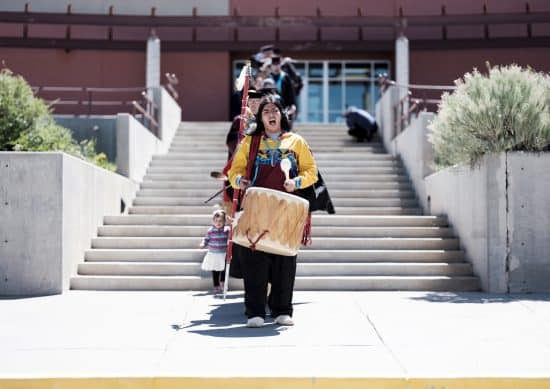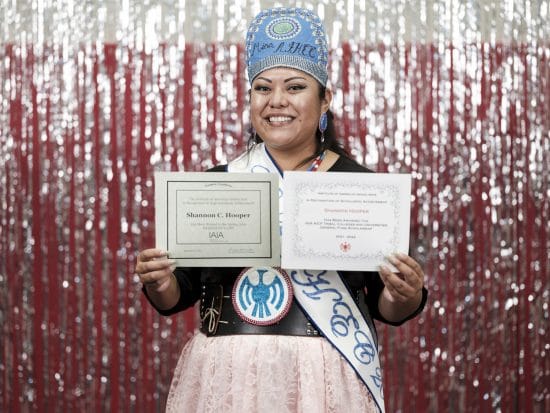To Lead is to Serve

2019 IAIA Commencement
Servant Leadership
Traditional tribal leadership manifests qualities reflected in the “servant leadership” model coined by Robert K. Greenleaf in 1970. Servant leadership focuses on one’s service to the community and the creation of an environment where everyone can realize their full potential. The priority is ensuring that community members’ needs are met.
TCU leadership can be defined in terms of service in which the stakeholders are students, administration, faculty, staff, and board of trustees. It is imperative that all are invested and have a sense of belonging and engagement in the college’s mission. This is manifested by our students as they discover and utilize their forms of expression while achieving their educational goals.
Engagement among campus stakeholders, however, does not occur automatically. It requires diligent efforts, dedication, and commitment by formal and informal leadership to implement strategies and programs that build trust and confidence in students.
Strategic Planning
An inclusive strategic planning process is crucial to engaging the college community to support student success. When I arrived at the Institute of American Indian Arts (IAIA), I walked around campus and asked 15 faculty and staff to share IAIA’s vision and mission statements. Not surprisingly, only one staff member could articulate the college’s mission and vision, so I embarked on a strategic planning process which required the participation of the entire community. After many focus group meetings and drafts, we finalized a viable, dynamic plan which is critical in developing vision and mission statements. Thus, our vision statement is “To be the premier educational institution for Native arts and cultures.” The mission statement is “To empower creativity and leadership in Native arts and cultures.” It is these edicts that guide our institutional values, mission objectives, and priorities.
In the focus group meetings with students, faculty, staff, board of trustees, alumni, and donors, I learned of their concerns and recommendations for IAIA’s future. In the faculty meetings, it became clear that there was insufficient space in several programs for students to create art. For example, the sculpture and painting programs were in spaces not designed as studios with proper lighting and ventilation. In fact, administrative offices were in the rooms originally designed as painting studios.

IAIA Museum Club
So, the food service program was moved to the new Center for Lifelong Education building that offered increased storage, cooking, and dining spaces. Fresh, locally sourced food is served when available, and there are no fryer vats, so fried food is not an option. Our café quickly became a popular meeting space for our students to enjoy healthy meals while networking with friends, faculty, and staff.
We ultimately constructed five new buildings that provided space for the sculpture and foundry program, science labs, classrooms, the college’s vast collection of contemporary Indigenous art, and a bookstore. The administrative offices were relocated to the new Welcome Center, freeing space to expand the painting, jewelry and ceramics studios, as well as the Student Art Gallery.
An inclusive strategic planning process is crucial to engaging the college community to support student success.
Shared Governance Model
I value the shared governance model in terms of formulating college policies and soliciting community input in decision-making. IAIA’s committee structure provides a process for obtaining advice and input from all stakeholders. The Standing Institutional committees include representatives from faculty, staff, administrators, and students, all with different points of view and mechanisms for reaching consensus in addressing issues and problem solving. I believe in the power of synergy, in which the efforts of two or more people are more successful than singular efforts. In other words, two heads are better than one.
The committee structure and process ensure participation by IAIA stakeholders in forming policies that support the shared governance model. Stakeholder representatives offer input and recommendations, but final decisions are made by department directors: Dean, Chief Financial Officer, President, or the IAIA Board of Trustees.

IAIA 2021 Scholarship Awards Luncheon
Student Voices in Leadership
I learned early about the power of student input when meeting with potential funders and supporters, congressional members, state legislators, tribal leaders, and donors. These various entities prefer to hear directly from students about their experiences and professional goals. Thus, leadership is foremost in IAIA’s Mission Statement: “To empower creativity and leadership in Native Arts and Cultures.” Accordingly, two students serve on college standing committees and developing leadership skills is embedded in their studies. We strive to develop a culture of leadership that encourages student involvement through challenging, respectful dialogue, accountability, and collaborative practices.
Leadership skills are a basic component of our courses. For example, students learn to pose issues or problems verbally and in writing, as they must, as professional artists, offer descriptions of their work. Our students are intelligent and creative but may lack the experience and verbal skills to perform well in a classroom environment, thus leadership development is included in course syllabi.
We also offer opportunities for student leadership. In addition to the Associated Student Government, clubs, and student organizations, we provide opportunities for professional development and training via internships, apprenticeships, and pathways to employment, all of which provide experiential and service-learning opportunities.
We encourage that the staff’s annual work plans include student leadership projects. For example, students conduct campus tours during open houses for potential students and donors. The Continuing Education Program recruits students as instructors, the Chief Financial Officer requires that student workers provide verbal reports to the IAIA Board of Trustees, and the Office of Institutional Advancement enlists student volunteers to help with fundraising events and writing thank-you notes to donors.
It is imperative that all are invested and have a sense of belonging and engagement in the college‘s mission.
Stories of Resilience
The pandemic provided unique challenges as we focused on strategies to protect our community. We had to pivot to online classes and respond to students’ challenges with home internet connectivity and economic and food insecurities.

IAIA Dance Circle
We encouraged vaccinations for faculty and staff; currently, 98% of students, faculty, and staff are fully vaccinated. The recent surge in positive cases caused by the Delta variant has led to increased vigilance, mitigation measures, and communication.
The pandemic reinforced the need for communication, empathy, and acknowledging community concerns. Given the abrupt changes and increased anxiety, we now hold monthly Town Hall meetings via Zoom for online students as well as the campus community.
Our cooperation and respect for others resulted in a relatively safe environment so that students continue to learn and create. A high percentage of students remain focused on their academic goals. Student enrollment has stabilized and graduate numbers increased in 2020 and 2021. These successes are due to the commendable efforts of our students.
Faculty and staff remain centered on developing our mission and programs to better serve Indigenous communities. In 2021, IAIA launched an MFA in Studio Arts and finalized plans for an MFA in Cultural Administration. In addition, we now offer a Certificate in Broadcast Journalism and are working towards establishing a Research Center for Contemporary Native Arts. The Center will greatly enhance scholarship in Indigenous arts and culture.
We are especially grateful to the IAIA Board of Trustees, Foundation Board of Directors, alumni, and individual donors in Santa Fe and nationally for making 2021 one of our most successful fundraising years. Mackenzie Scott and Dan Jewett provided unrestricted gifts to the college and to the IAIA Museum of Contemporary Native Arts. Our annual Scholarship Fundraiser in August resulted in more than $400,000 for student scholarships.
Striving to Make a Difference
I am honored to have served as president at four tribal colleges over 37 years. It is a blessing in many ways as I was given ample opportunities to improve college education for our people. My goal is to become a better president by learning from the college community, donors, my colleagues at other TCUs, and through service on local and national boards. And I am grateful to all.